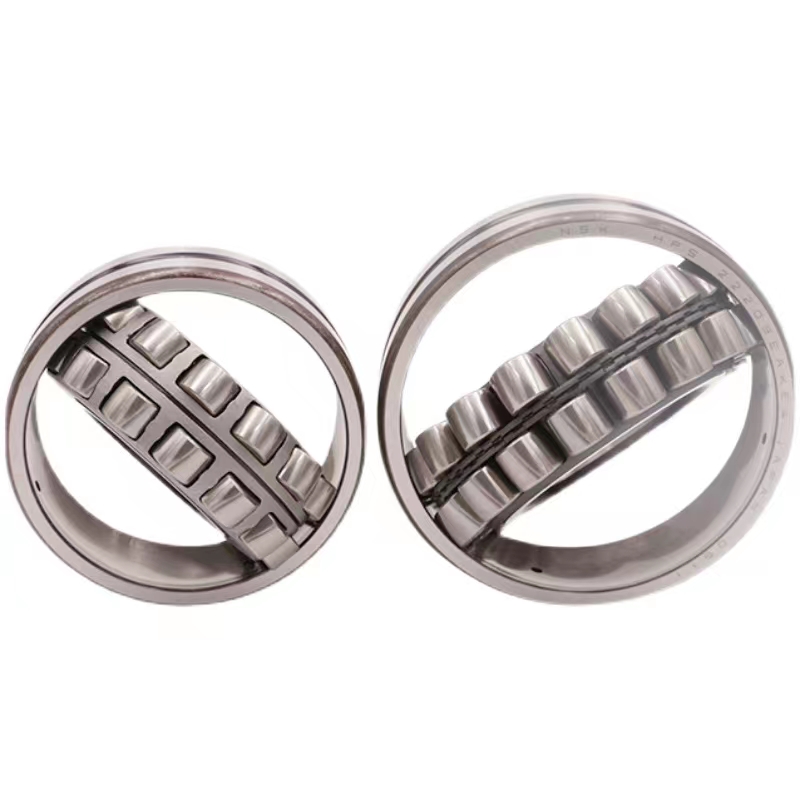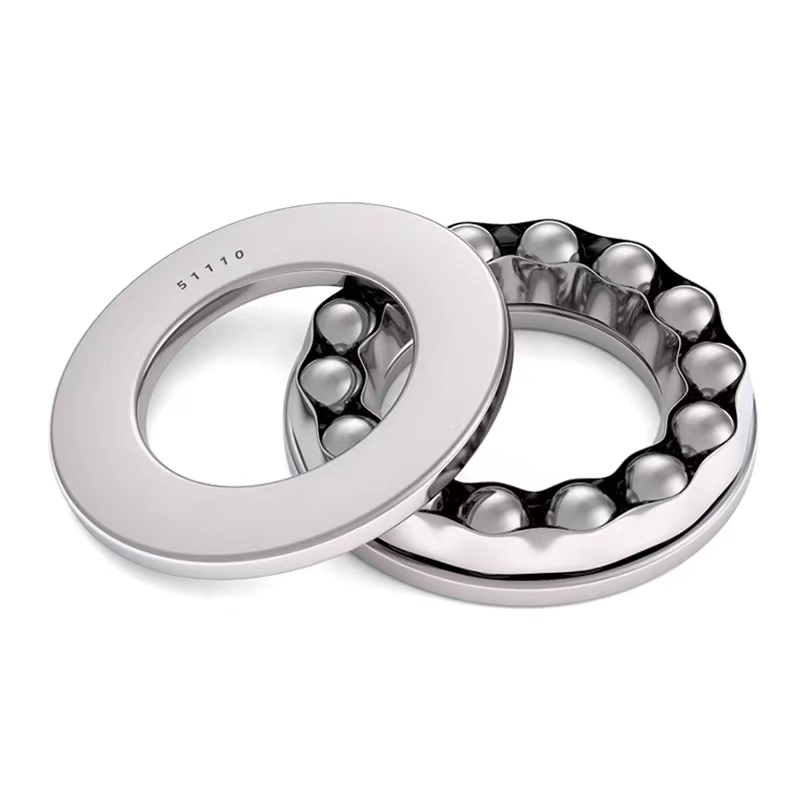3D printing bearings with an FDM printer can be an iffy endeavor, but it doesn’t have to be that way. [Matvey Kukuy]’s Ultimate 608 Bearing with Calibration Kit is everything you’ll need to dial in and print functional 608-style print-in-place bearings on your 3D printer.
[Matvey] found that there are two key tolerances to get right. And by “get right” he means “empirically determine which works best with your filament and printer”. But don’t worry, there’s no need to get into CAD work to make that happen. [Matvey] has exported a staggering 64 slightly different calibration models (and their matching production versions) along with a printable testing tool. With the help of a step-by-step process that resembles a sort of binary search, one can take the Goldilocks approach to find just the right model for one’s filament and printer in a minimum of steps. Skiff Bearings

There’s one more tip as well: [Matvey] says that once you determine the best model to use, don’t fill the print bed with copies, unless you want a bed full of possibly non-working bearings! Why is this? A 3D printer prints a bed full of objects slightly differently than it prints a single one, and since the margin for error on the perfectly-selected bearing is so small, that can be enough to keep it from working. To print more than one bearing at a time, position them far from each other and use something like PrusaSlicer’s sequential printing, which is an option to print each object completely before starting the next one.
[Matvey]’s own best results came from printing with PLA at a layer height of 0.16 mm. He also used grease in the bearing to improve performance and extend its life. He doesn’t specify what kind of grease he used, but we’d recommend a plastic-safe grease like PTFE-based Super Lube.
Have you used 3D printed bearings in a project? Would [Matvey]’s design be helpful to you? Let us know all about it in the comments.
What’s the point of separately printed bearings though? They perform worse and cost more all things considered than just using real bearings.
You may want a bearing that is inside something else or otherwise non-accessible. Or you may just want to climb that mountain.
Sounds like the best of both world would be a pause and a real BB in the part, assuming the printing direction is compatible…
I think “non accessible” as a design error, unless you want to make something with a high chance of failure right out of the printer because the bearing didn’t print just perfectly.
b) they’d be lighter, you can integrate them into a part, perhaps where there’s no way to press one in, there’s one less post-processing step required, probably other reasons.
b) If you design the bearing to be integral or you can’t install it otherwise, that’s a fault in design because it needs to print right every single time to work. Would be a bugger to find out that the bearing is jammed after printing for 24 hours and wasting half a mile of filament.
Not really a fault in the design, as there are so many cases when it will be the only/better option – you need something that rotates freely but isn’t steel and a bearing surface of Delrin type stuff isn’t suitable – perhaps for chemical resistances, perhaps for weight/magnetic reasons, maybe for speed of rotation issues why not print in place. You need a short lifespan jig, perhaps that you know won’t survive this use no matter how you build it, again print in place is cheap and easy and at that point you can skip the separate bearings and print them integral to the rest of the jig quite likely!
There is a time and place for serviceable and replaceable bearings, but its not universally going to be the case that such a thing even makes sense. And then even if it does there are reasons you won’t be able to use metal bearings – like they do cost too damn much – argue all you like but if you have a printer a bearing like this costs are measured in pennies even with the electric bill taken into account!
And a failed print after day(s) of printing is par for the course, it will happen, and what you do is clean up and hit the go again button. But with a well setup printer and good filament it won’t happen very often at all. Heck It doesn’t happen very often with my really cheap and crappy but still working printer, printing fillament that hasn’t been stored well and is stupendously old (exactly one failure that wasn’t on the first layer or two when any sane operator checks), and actually never happened to me with the mechanically good printer who’s brain let out the magic smoke, and that printer got a great deal of use.
(eventually it will get a smoothieboard V2 transplant and I’ll probably start printing more often again, as so far at least I can wait to have it back in working order, its a minor annoyance to deal with the rickety one when I have to print, and it is a good excuse to not fix it yet while simultaneously justifies the KS costs for V2 to myself)
b) they’ll be far heavier than a steel bearing for the same load capacity, and probably cost more in filament.
That said, I do think there are not-unreasonable applications for this. a) and c) are definitely the biggest reasons, though.
> far heavier than a steel bearing for the same load capacity This I can agree with, but then the cheapest thinest most rubbishy steel bearings you can actually buy have rather huge load rating for most of the tasks they are employed in – your using them because its an off the shelf part – so somewhat affordable option, that exceeds the requirement. The printed one of the same form factor likely is more than capable enough as a replacement in most of these situations, and lighter. I agree it can’t take the same load, but in most cases it isn’t likely to need to.
>probably cost more in filament. There I’m very very doubtful, as there really isn’t much weight of plastic in these things and filament is pretty damn cheap.
Sometimes you need a bearing with unusual specifications in material or size, weight, etc… Ordering custom made ones from professional company’s can take months (i know :/ ).
The alternative of 3d printing one, for testing fitment and functionality, can be useful. Allthhough i admit, it’s very niche.
Then the bearing doesn’t necessarily have to be functional. If you need the shaft to rotate, it can be a sleeve bearing that just looks like a ball bearing for the show.
same reason for making crappy plastic parts in the first place…it’s kind of convenient in the moment even if it doesn’t make a very high quality part. sometimes it’s “good enough” and sometimes it just saves you a trip to the hardware store in the middle of your prototyping session but you throw it out before making the one you actually use.
i mean, i’ve 3d printed a funny screwdriver once. it was absolutely unacceptable at the task, it self-destructed after a dozen screws. hey what a great coincidence, i only had a dozen screws like that to remove. it was perfect!
Sometimes it’s because you need something very basic that doesn’t demand a real bearing. Low weight, limited use is perfect for 3d printed bearings. I have several around my house, and all are doing their job great.
Sometimes you just need something here and now and not either 100 miles away or that’ll cost more in gas to pick up locally than it’s worth. Not everyone has all parts at all times when they may need them.
Would I expect print in place bearings to last a long time or operate particularly smoothly? Absolutely not, but if I was in a pinch and needed to bodge something in half an hour that wasn’t very critical that only needed to survive long enough to do a short job then this is a potentially convenient option.
Assuming something is pointless just because you cant think of a use case based on your specific experiences is the same flawed logic I see over and over again in these comments sections, ironic for a site that’s supposed to foster a sense of creatively in finding uses for things outside of their original purpose.
Where are you buying bearings that cost less than two cents in plastic?
The real answer: not every use case requires hardened steel bearings. I wouldn’t want this on my skateboard but plenty of my 3d printed projects need bearing surfaces but would never be under the kind of load where a steel solution would be required.
So, like most things in engineering, the answer is “it depends on the use case”. You have decided that one solution is the best answer for all uses, and I suspect that is an overly-narrow approach to the solution space. You’d do well to consider more options than just the ones you already work with today.
Does no one make a groove in the model between two pieces, fill the groove with ball bearings, then screw them together? The actual bearing balls are super cheap, and they roll smoother than anything printed does.
I haven’t figured out how to make roller bearings like the ones pictured, but it seems as if it would be a similar process.
I love these bearings but I’ve had trouble getting a smooth roll out of 3d printed material.
A good bearing needs a ball or roller cage to keep them apart so they don’t grind together. A while ago I quickly made this design for use with steel BB shot. https://www.thingiverse.com/thing:1769802
This looks like a useful model, Gregg. Could you post the design files too? That would make it easier to “use your CAD software to punch a hole in the middle”
If’n y’all can print ‘functional’ 608 bearings, I’d say your printer/software/materials/savvy is in pretty good balance. The point of the exercise is how well everything else will print after you have a handle in what it takes for your rig to do its job well.
They do not work. It is an artist interpretation of a ball bearing. These just tear themselves apart trying to rotate sideways. You can oil them, but then why not just slide plastic on plastic in the first place.
This helped me, maybe it works for you as well: https://www.youtube.com/watch?v=Ku8BOBwD4hc
https://en.wikipedia.org/wiki/Ball_bearing Look at the ball spiraling and not just rotating around it’s axis. The 3d rollers just scrape everywhere. Against each other, against the diagonal surface, outer and inner rings… none of it matches
Hey, I think all things considered (which they appear to be on this thread) that it’s a pretty cool project. Could someone put up the minimum RT and TT for a creality Ender 3 so I don’t have to calibrate it? Is there a way to print smaller versions and still perform the binary search? I’m running a little low on PLA.
Please be kind and respectful to help make the comments section excellent. (Comment Policy)
This site uses Akismet to reduce spam. Learn how your comment data is processed.

Ball Roller Bearings By using our website and services, you expressly agree to the placement of our performance, functionality and advertising cookies. Learn more